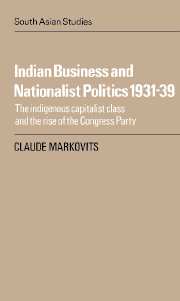 Indian Business and Nationalist Politics 1931–39
Indian Business and Nationalist Politics 1931–39 Book contents
- Frontmatter
- Contents
- Preface
- Abbreviations
- Introduction
- 1 Indian capital
- 2 Crisis and opportunities
- 3 Business, Civil Disobedience and the reforms 1931–1935
- 4 The turning point: capitalists and Congressmen 1935–1937
- 5 Business, the central government and the Congress 1937–1939
- 6 Indian business and the Congress provincial governments 1937–1939
- Conclusion
- APPENDICES
- Biographical notes
- Bibliography
- Glossary
- Index
2 - Crisis and opportunities
Published online by Cambridge University Press: 25 October 2009
- Frontmatter
- Contents
- Preface
- Abbreviations
- Introduction
- 1 Indian capital
- 2 Crisis and opportunities
- 3 Business, Civil Disobedience and the reforms 1931–1935
- 4 The turning point: capitalists and Congressmen 1935–1937
- 5 Business, the central government and the Congress 1937–1939
- 6 Indian business and the Congress provincial governments 1937–1939
- Conclusion
- APPENDICES
- Biographical notes
- Bibliography
- Glossary
- Index
Summary
Between 1930 and 1933, the Indian economy as a whole was severely affected by the world depression while the post-1933 recovery had only a limited impact on India. However, the industrial sector was spared the worst consequences of the crisis and its expansion continued at a more rapid pace than in the 1920s. In spite of the overall depression in the economy, there were thus opportunities for Indian capitalists to expand.
The impact of the world depression
The world depression hit India in full force between 1930 and 1933. Table 4 shows that the fall in wholesale prices between 1929 and 1933 was more pronounced in India than in the industrial countries.
The fall in the prices of agricultural commodities was even greater. On the basis of 1928 = 100, the index of agricultural prices stood at 48 in 1933. But the impact of the fall in prices on the internal economy was cushioned by the fact that the bulk of agricultural output was not produced for the market. As foodgrains production responded only marginally to price fluctuations and more to weather conditions, given a normal rainfall it did not show a downward trend during the depression years.
The impact of the depression on the external position of the Indian economy was, in contrast, very great. The bulk of Indian exports consisted of agricultural commodities while imports were mostly manufactured products. Therefore during the depression years India's terms of trade deteriorated considerably, as shown in Table 5.
The consequence was a considerable reduction in India's trade surplus on merchandise transactions. Whereas during the 1920s the surplus on merchandise transactions averaged Rs 100 crores, between 1929–1930 and 1933–1934 it averaged only Rs 40 crores.
- Type
- Chapter
- Information
- Indian Business and Nationalist Politics 1931–39The Indigenous Capitalist Class and the Rise of the Congress Party, pp. 41 - 67Publisher: Cambridge University PressPrint publication year: 1985


